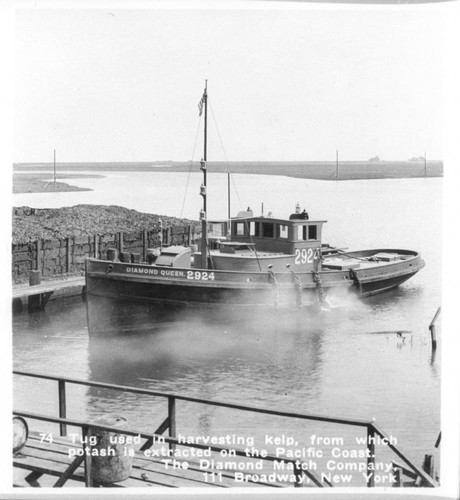a notebook

This morning, entering some assorted search terms along the lines of word combinations like "Hercules Powder Company archives collections," I found a photo album. California Revealed links this album to the California Railroad Museum collection, but I was confused about this, as I've seen some of the photographs before attributed to the South Bay Historical Society, which I used in my piece about burning kelp for potassium to make gunpowder in Chula Vista. I suppose these company postcards must have circulated, but I will need to ask the archivists for more information (n.b. the album is added to the Internet Archive, too). This seems like an omen, meaning that I'm obligated to come back to the Hercules Powder Company and its products more thoroughly.
confusing chemistries
Another detail caught my attention. The archivists seem to have believed that the landscapes represented in this album were on the "San Pablo Bay" in northern California (San Pablo Bay is just another water body that connects with the estuary of the San Francisco Bay). My understanding all along was that these facilities and kelp-harvesting ships were located in Southern California (my understanding is that there is no kelp in the Bay, besides). A great source about this operation is Peter Neushul's "Seaweed for War" (1989).
The archival meta-data also implies that the kelp operations were used for dynamite: "The DuPont corporation and Lafkin & Rand Powder Company incorporated the Hercules Powder Company in 1882 to manufacture Hercules powder (a special form of dynamite)." This adds to more confusion, because, as far as I know, the Chula Vista operation was dedicated to simple gunpowder (thus, "Gunpowder Point" today), not any dynamite-like explosive.
I'm not writing this note to correct anyone or accuse them of archival sloppiness. What is interesting to me is that these mistakes and confusions tell us something important about the everyday make-up of explosives. These mistakes reveal the scientific distance of these substances that contain, nevertheless, fairly mundane materials from up-close environments.
everydayness of explosive landscapes
The "everydayness" of explosive landscapes have literally created urban development writ large, but the very same environmental resources extracted for explosives seem to exist in tenuous zones that will sink under sea level rise. In this way, explosives, chemicals, and fossil fuel industries--capitalist enterprises that tend toward integrated monopolies of materials (e.g. Ashland now owns the defunct Hercules co.)--have assembled a vast suspicious package: the "earth" itself. Note to self: turn back around to the literature on capital accumulation and nature.
To conclude for now, what begins to shape up in my mind is a landscape process of becoming intimate with such explosivity in the everyday, from the sources of diatomaceous clay for dynamite to the kelp for gunpowder; from the ivory nut plantations on Pacific coral archipelagos to --dunno-- the factories for nitroglycerin pharmaceutical vasodilatory drugs.
additional finds today
photographs and ephemera from Hercules Inc. (one of its many corporate mutations)
Hercules Powder Co headquarters(?) in Wilmington, Delaware (1939)
a Hercules plant in Victoria, Au
explosions at Hercules plant in Carthage Missouri 50+ years ago
what else I'm going over these days...
Myers, Natasha. Rendering Life Molecular: Models, Modelers, and Excitable Matter. Durham: Duke University Press, 2015. https://worldcat.org/en/title/892162549
Papadopoulos, Dimitris. Experimental Practice: Technoscience, Alterontologies, and More-Than-Social Movements. Durham: Duke University Press, 2018. https://worldcat.org/en/title/1019833789
Romero, Adam. Economic Poisoning: Industrial Waste and the Chemicalization of American Agriculture. Oakland, California: University of California Press, 2021. https://www.ucpress.edu/book/9780520381568/economic-poisoning
parallel inquiries...
Fascinating research from Jeffrey Nesbit on spaceports and the continuities of earth-moving from past to present at Cape Canaveral FL, newly published in what appears to be a forthcoming special issue on Earthly Entanglements with Outer Space, edited by Julie Michelle Klinger and Eleanor Armstrong, in EPD (h/t Adam Levy):
Nesbit, J. S. (2023). Earthmoving for the extraterrestrial. Environment and Planning D: Society and Space, 0(0). https://doi.org/10.1177/02637758231204701
You just read issue #4 of Geographies of Explosivity. You can also browse the full archives of this newsletter.